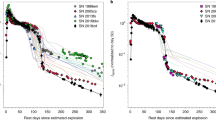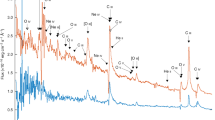Abstract
SUPERNOVAE are classified observationally as type I (which have no hydrogen emission lines in their optical spectra) or type II (which do have hydrogen lines), and are further subdivided1 into types Ia, Ib, Ic, IIP, IIL and IIb. Type II supernovae are generally thought to result from the explosion of massive stars, and type Ia supernovae from white-dwarf stars that have accreted sufficient mass from a companion to trigger explosion1,2. The origins of types Ib and Ic are much less clear. The Ic class has been particularly controversial, with two main alternatives: the explosion of a massive star that has lost its hydrogen and helium envelopes through fast stellar winds, exposing the carbon- and oxygen-rich core; or the transfer of material to a companion, leaving a small, bare carbon–oxygen (C + O) star which subsequently explodes3,4. We show here that the observed characteristics of SN1994I (in the nearby galaxy NGC5194), which has recently5,6 been classified as type Ic, are best understood on the basis of the second of the two alternatives above: that the progenitor was in a close binary system and lost its outer envelopes, leaving a C + O star (of mass ≈ 2 solar masses) which exploded when its iron core collapsed.
This is a preview of subscription content, access via your institution
Access options
Subscribe to this journal
Receive 51 print issues and online access
$199.00 per year
only $3.90 per issue
Buy this article
- Purchase on Springer Link
- Instant access to full article PDF
Prices may be subject to local taxes which are calculated during checkout
Similar content being viewed by others
References
Branch, D., Nomoto, K. & Filippenko, A. V. Comments Astrophys. 15, 221–237 (1991).
Wheeler, J. C. & Harkness, R. P. Rep. Prog. Phys. 53, 1467–1557 (1990).
Filippenko, A. V., Porter, A. C. & Sargent, W. L. W. Astr. J. 100, 1575–1587 (1990).
Wheeler, J. C. et al. Astrophys. J. 313, L69–L73 (1987).
Schmidt, B., Challis, P. & Kirshner, R. IAU Circ. No. 5966 (1994).
Clocchiatti, A., Brotherton, M., Harkness, R. P. & Wheeler, J. C. IAU Circ. No. 5972 (1994).
Woosley, S. E., Langer, N. & Weaver, T. A. Astrophys. J. 411, 823–839 (1993).
Shigeyama, T., Nomoto, K., Tsujimoto, T. & Hashimoto, M. Astrophys. J. 361, L23–L27 (1990).
Nomoto, K., Filippenko, A. V. & Shigeyama, T. Astr. Astrophys. 240, L1–L4 (1990).
Lucy, L. B. Astrophys. J. 383, 308–313 (1991).
Swartz, D. A., Filippenko, A. V., Nomoto, K. & Wheeler, J. C. Astrophys. J. 411, 313–322 (1993).
Yamaoka, H., Shigeyama, T. & Nomoto, K. Astr. Astrophys. 267, 433–438 (1993).
Wheeler, J. C. & Swartz, D. A. in Evolution of Massive Stars: Confrontation Between Theory and Observation (eds Vanbeveren, D. et al.) 425–437 (Vrije Univ., Brussels, 1994).
Bhattacharya, D. & van den Heuvel, E. P. J. Phys. Rep. 203, 1–124 (1991).
Habets, G. M. H. J. Astr. Astrophys. 187, 209–230 (1986).
Nomoto, K. & Hashimoto, M. Phys.Rep. 163, 13–36 (1988).
Van den Heuvel, E. P. J. in Interacting Binaries (eds Nussbaumer, H. & Orr, A.) 263–474 (Springer, Berlin, 1994).
Pols, O. R., Coté, J., Waters, L. B. F. M. & Heise, J. Astr. Astrophys. 241, 419–438 (1991).
Van den Bergh, S. A. Rev. Astr. Astrophys. 29, 363–407 (1991).
Muller, R. A. et al. Astrophys. J. 384, L9–L13 (1992).
Swartz, D. A. & Wheeler, J. C. Astrophys. J. 379, L13–L16 (1991).
de Vaucouleurs, G. Astrophys. J. 227, 729–755 (1979).
Jeffery, D. J., Branch, D., Filippenko, A. V. & Nomoto, K. Astrophys. J. 377, L89–L92 (1991).
Shigeyama, T. et al. Astrophys. J. 420, 341–347 (1994).
Rupen, M. P. et al. IAU Circ. No. 5963 (1994).
Yamaoka, H., Nomoto, K., Shigeyama, T. & Thielemann, F.-K. Astrophys. J. 393, L55–L58 (1992).
Nomoto, K., Yamaoka, H., Shigeyama, T. & Iwamoto, K. in Supernovae and Supernova Remnants (eds McCray, R. & Wang, Z.) (IAU colloq. No. 145, Kluwer, Dordrecht, in the press).
Panagia, N. in High Energy Phenomena Around Collapsed Stars (ed. Pacini, F.) 33–49 (Reidel, Dordrecht, 1987).
Leibundgut, B. et al. Astrophys. J. 371, L23–L26 (1990).
Leibundgut, B. et al. Astr. J. 105, 301–313 (1993).
Author information
Authors and Affiliations
Rights and permissions
About this article
Cite this article
Nomoto, K., Yamaoka, H., Pols, O. et al. A carbon–oxygen star as progenitor of the type Ic supernova 1994I. Nature 371, 227–229 (1994). https://doi.org/10.1038/371227a0
Received:
Accepted:
Issue Date:
DOI: https://doi.org/10.1038/371227a0
This article is cited by
-
A radio-detected type Ia supernova with helium-rich circumstellar material
Nature (2023)
-
Gamma-Ray Bursts and magnetar-forming Supernovae
Astrophysics and Space Science (2011)
-
A massive star origin for an unusual helium-rich supernova in an elliptical galaxy
Nature (2010)
-
A neutron-star-driven X-ray flash associated with supernova SN 2006aj
Nature (2006)
Comments
By submitting a comment you agree to abide by our Terms and Community Guidelines. If you find something abusive or that does not comply with our terms or guidelines please flag it as inappropriate.



